Multi-Objective Optimization for Multi-Task Learning
CVPR Tutorial
Xi Lin
June 19, 2023
Outline
- Finding a Single Pareto Solution
- Finding a Set of Pareto Solutions
- Building a Model for the Whole Pareto Set
- Rethinking MOO for MTL and Future Directions
Finding a Single Pareto Solution
Multi-Task Learning (MTL)

- MTL: Solve multiple related tasks at the same time
MTL Loss
\[\min_{\theta} \mathcal{L}(\theta) = \sum_{i} w_i\mathcal{L}_i(\theta)\]
Drawbacks of MTL Loss
MTL Loss
\[\min_{\theta} \mathcal{L}(\theta) = \sum w_i\mathcal{L}_i(\theta)\]
\[\min_{\theta} \mathcal{L}(\theta) = \sum {\color{yellow}{w_i}}\mathcal{L}_i(\theta)\]
\[\min_{\theta} \mathcal{L}(\theta) = \sum w_i\color{cyan}{\mathcal{L}_i(\theta)}\]
\[\min_{\theta} \mathcal{L}(\theta) = \color{orange}{\sum} w_i\mathcal{L}_i(\theta)\]
- Weights:
- Manually chosen by practitioners
- Exhaustive search might be needed
- Tasks:
- Might be conflicted with each other
- No single best solution
- Simple Weighted-Sum:
- Can't find any solution on concave Pareto front

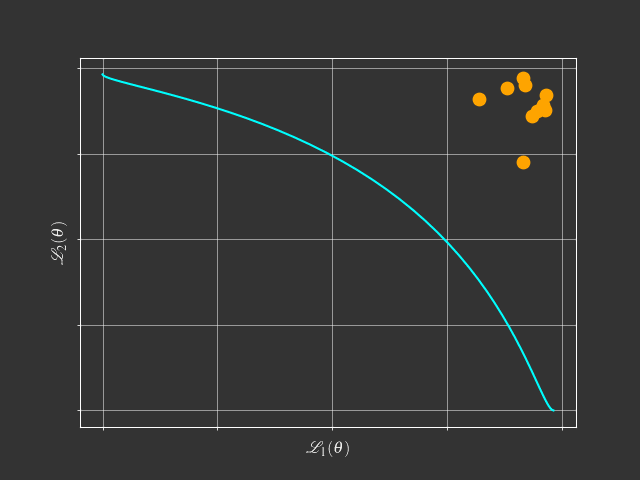
View Point of Multi-Objective Optimization
$$\min_{\theta} \mathcal{L}(\theta) = (\mathcal{L}_1(\theta),\mathcal{L}_2(\theta),\dots,\mathcal{L}_m(\theta))$$- Goal: Find a Pareto optimal solution for MTL with gradient-based method
- Motivation: Karush-Kuhn-Tucker (KKT)Condition$^{[1,2]}$
There exist $\alpha_1, \dots, \alpha_m \geq 0$ such that $\sum_{i=1}^m \alpha_i = 1$ and $\sum_{i=1}^m \alpha_i \nabla \mathcal{L}_i(\theta) = 0$
- Any $\theta$ that satisfies this condition is called a Pareto stationary solution.
- Sener and Koltun, Multi-Task Learning as Multi-Objective Optimization, NeurIPS 2018.
- $^1$Fliege and Svaiter, Steepest descent methods for multicriteria optimization, Mathematical Methods of Operations Research 2000.
- $^2$Schäffler et. al., Stochastic method for the solution of unconstrained vector optimization problems. Journal of Optimization Theory and Applications 2002.
Multi-Gradient Descent Algorithm (MGDA)
$$\min_{\theta} \mathcal{L}(\theta) = (\mathcal{L}_1(\theta),\mathcal{L}_2(\theta),\dots,\mathcal{L}_m(\theta))$$- Goal: Find a Pareto optimal solution for MTL with gradient-based method
- Method: Multi-Gradient Descent Algorithm (MGDA)$^{1}$
$$
\begin{equation}
\min_{\alpha_1,\dots,\alpha_m} \left\{\left\|\sum_{i=1}^m \alpha_i\nabla_{\theta}\mathcal{L}_i(\theta)\right\|_2^2 \Bigg\rvert \sum_{i=1}^m \alpha_i=1, \alpha_i\geq 0 \text{ } \forall i\right\} \nonumber
\end{equation}
$$
- A: $\underbrace{\left\|\sum_{i=1}^m \alpha_i\nabla_{\theta}\mathcal{L}_i(\theta)\right\|_2^2}_{\text{Pareto Stationary Solution}} = 0$
- B: $\underbrace{d = \sum_{i=1}^m\alpha_i\nabla_{\theta}\mathcal{L}_i(\theta)}_{\text{Valid Gradient Direction}}$
- Optimization: Frank-Wolfe algorithm$^2$ to obtain $d=\sum_{i=1}^m\alpha_i\nabla_{\theta}\mathcal{L}_i(\theta)$
- Sener and Koltun, Multi-Task Learning as Multi-Objective Optimization, NeurIPS 2018.
- $^1$Jean-Antoine Désidéri, Multiple-gradient descent algorithm (MGDA) for multiobjective optimization, Comptes Rendus Mathematique 2012.
- $^2$Martin Jaggi, Revisiting Frank-Wolfe: Projection-Free Sparse Convex Optimization, ICML 2013.
Linear Scalarization vs MGDA


- Sener and Koltun, Multi-Task Learning as Multi-Objective Optimization, NeurIPS 2018.
- Jean-Antoine Désidéri, Multiple-gradient descent algorithm (MGDA) for multiobjective optimization, Comptes Rendus Mathematique 2012.
- Martin Jaggi, Revisiting Frank-Wolfe: Projection-Free Sparse Convex Optimization, ICML 2013.
Promising Performance of Pareto Solution for MTL

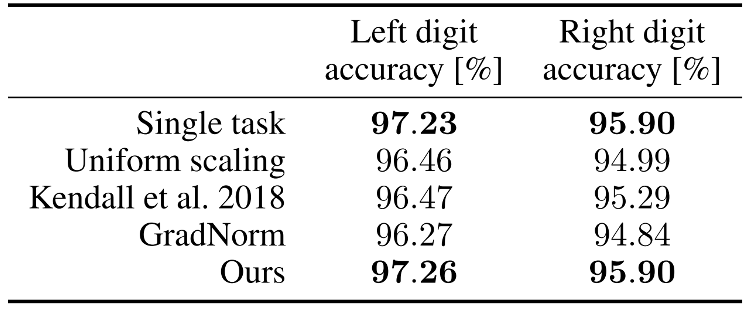
- MultiMNIST: MTL version of MNIST Classification
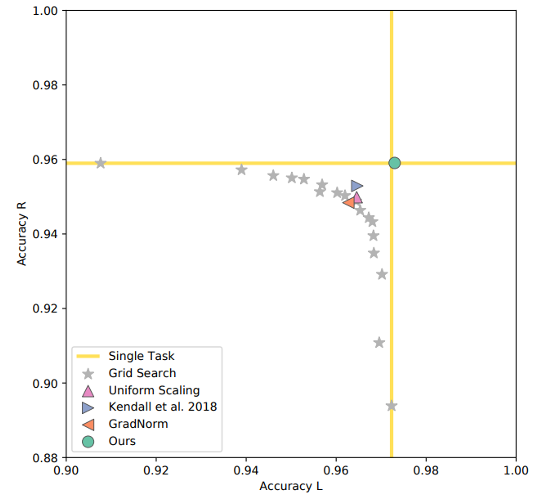
- Sener and Koltun, Multi-Task Learning as Multi-Objective Optimization, NeurIPS 2018.
- Sabour, Frosst, and Hinton, Dynamic Routing Between Capsules, NeurIPS 2017.
Promising Performance of Pareto Solution for MTL

- Cityscapes Scene Understanding:
- Semantic Segmentation
- Instance Segmentation
- Depth Estimation

- Sener and Koltun, Multi-Task Learning as Multi-Objective Optimization, NeurIPS 2018.
- Cordts et. al., The Cityscapes Dataset for Semantic Urban Scene Understanding, CVPR 2016.
Different Ways to Find the Gradient
- PCGrad: Gradient Surgery for Multi-Task Learning, NeurIPS 2020.
- CAGrad: Conflict-Averse Gradient Descent for Multi-task Learning, NeurIPS 2021.
- I-MTL: Towards Impartial Multi-Task Learning, ICLR 2020.
- RotoGrad: Gradient Homogenization in Multitask Learning, ICLR 2022.
- Nash-MTL: Multi-Task Learning as a Bargaining Game, ICML 2022.
- MoCo: Mitigating Gradient Bias in Multi-Objective Learning, ICLR 2023.







- Related Work on Weight Adjustment:
- Uncertainty: MTL Using Uncertainty to Weigh Losses for Scene Geometry and Semantics, CVPR 2018.
- GradNorm: Gradient Normalization for Adaptive Loss Balancing, ICML 2018.
- DWA: End-to-End Multi-Task Learning with Attention, CVPR 2019.
- Just Pick a Sign: Optimizing Deep Multitask Models with Gradient Sign Dropout, NeurIPS 2020.
Finding a Set of Pareto Solutions
There are Many Pareto Solutions


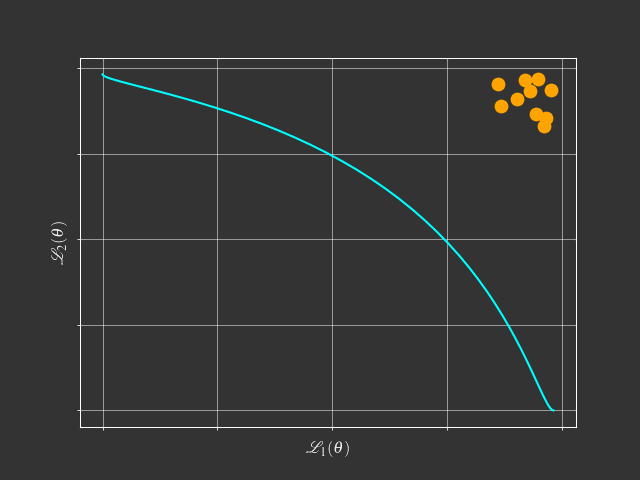
- Pareto Solutions represent different trade-offs among tasks
- Fixed Linear Scalarization can't find the concave Pareto front.
- Adaptive Methods can find a single solution.
- Pareto MTL can find a set of diverse Pareto solutions.
- Lin et. al., Pareto Multi-Task Learning, NeurIPS 2019
Pareto Multi-Task Learning
- Goal: Find:
a Pareto optimal solution
- set of diverse Pareto solutions
- Method:
Decompose MTL into multiple subproblems
$$
\begin{equation}
\begin{aligned}
\min_{\theta} \quad & \left(\mathcal{L}_1(\theta),\mathcal{L}_2(\theta),\dots,\mathcal{L}_m(\theta)\right) \\
\text{s.t.} \quad & \mathbf{\mathcal{L}(\theta)} \in \Omega_k = \{\mathbf{v} \in \mathbb{R}^{m}_+ | \mathbf{u}^T_j\mathbf{v} \leq \mathbf{u}^T_k\mathbf{v}, \forall j \in \{1, \dots, K\}\} \nonumber
\end{aligned}
\end{equation}
$$
Idea borrowed from MOEA/D and MOEA/D-M2M
Decompose MTL into multiple subproblems
$$
\begin{equation}
\begin{aligned}
\min_{\theta} \quad & \left(\mathcal{L}_1(\theta),\mathcal{L}_2(\theta),\dots,\mathcal{L}_m(\theta)\right) \\
\text{s.t.} \quad & \mathbf{\mathcal{L}(\theta)} \in \Omega_k = \{\mathbf{v} \in \mathbb{R}^{m}_+ | \mathbf{u}^T_j\mathbf{v} \leq \mathbf{u}^T_k\mathbf{v}, \forall j \in \{1, \dots, K\}\} \nonumber
\end{aligned}
\end{equation}
$$
Rewrite constraint: $\mathbf{G}_j(\theta_t)=(\mathbf{u}_j-\mathbf{u}_k)^T\mathbf{\mathcal{L}(\theta_t)} \leq 0, \forall j \in \{1, \dots, K\}$
KKT Condition for Restricted Pareto Stationary Solution
There exist $\alpha_i \geq 0, \beta_i \geq 0 \text{ } \forall i,j$ such that $\sum_{i}\alpha_i + \sum_{j}\beta_j = 1$ and $\sum_i \alpha_i \nabla \mathcal{L}_i(\theta) + \sum_j \beta_j\mathbf{\mathcal{G}_j}(\theta) = 0$
Find a gradient direction for each subproblem
$$
\begin{equation}
\min_{\alpha_i,\beta_j, \forall i,j} \left\{\left\|\sum_{i} \alpha_i\nabla_{\theta}\mathcal{L}_i(\theta)+\sum_{j} \beta_j\nabla_{\theta}\mathcal{G}_i(\theta)\right\|_2^2 \Bigg\rvert \sum_{i} \alpha_i + \sum_j \beta_j=1, \alpha_i\geq 0,\beta_j \geq 0 \text{ } \forall i,j\right\} \nonumber
\end{equation}
$$
- Lin et. al., Pareto Multi-Task Learning, NeurIPS 2019.
- Zhang and Li, MOEA/D: A Multiobjective Evolutionary Algorithm Based on Decomposition, TEVC 2007.
- Liu et.al., Decomposition of a Multiobjective Optimization Problem Into a Number of Simple Multiobjective Subproblems, TEVC 2013.
- Fliege and Svaiter, Steepest descent methods for multicriteria optimization, Mathematical Methods of Operations Research 2000.
Diverse Pareto Sets for MTL Problems

- Sabour, Frosst, and Hinton, Dynamic Routing Between Capsules, NeurIPS 2017
- Xiao et. al., Fashion-MNIST: a Novel Image Dataset for Benchmarking Machine Learning Algorithms, arXiv 2017
Other Methods to Find Diverse Pareto Solutions
- Exact Pareto Optimal (EPO) Search, ICML 2020.
- Weighted Chebyshev-MGDA (XWC-MGDA), NeurIPS 2021.
- Hypervolume (HV) Maximization, EMO 2023.
- Efficient Continuous Pareto Exploration, ICML 2020.


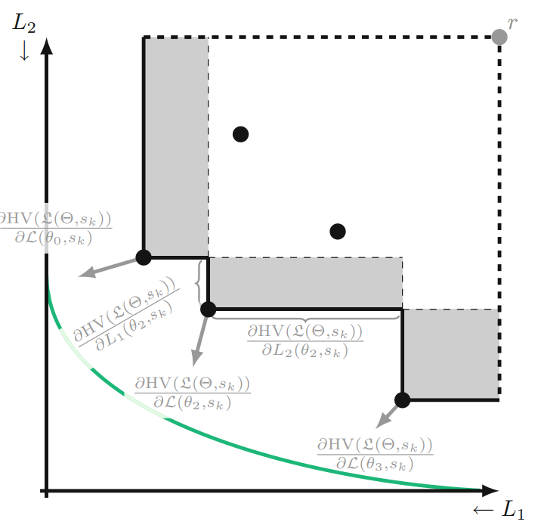

- Tchebycheff Procedure for Multi-task Text Classification, ACL 2020.
- Multi-Objective Stein Variational Gradient Descent (MO-SVGD), NeurIPS 2021.
- The Stochastic Multi-Gradient Algorithm for MOO and its Application to Supervised Machine Learning, Annals of Operations Research 2021.
- Pareto Navigation Gradient Descent: a First-Order Algorithm for Optimization in Pareto Set, UAI 2022.
- Stochastic Multiple Target Sampling Gradient Descent, NeurIPS 2022.
Building a Model for the Whole Pareto Set
There could be Infinite Pareto Solutions


- A few solutions cannot cover the whole Pareto front
- Storing many solutions lead to high computational/memory cost
- Ma and Du et.al., Efficient Continuous Pareto Exploration in Multi-Task Learning, ICML 2020.
Learning the Whole Pareto Set/Front
- Goal: Find a,
Pareto optimal solutionset of diverse Pareto solutions- model to approximate the whole Pareto set
- Navon and Shamsian et. al., Learning the Pareto Front with Hypernetwork, ICLR 2021.
- Lin et. al., Controllable Pareto Multi-Task Learning, arXiv 2021.
Preference-Conditioned Pareto Set Model
- Goal: Build a model to approximate the whole Pareto set

- By adjusting the preferences, decision-makers can explore any trade-off Pareto solutions on the approximate Pareto set/front.
- Navon and Shamsian et. al., Learning the Pareto Front with Hypernetwork, ICLR 2021.
- Lin et. al., Controllable Pareto Multi-Task Learning, arXiv 2021.
HyperNetwork-based Pareto Set Model
- Goal: Build a model to approximate the whole Pareto set
- Method: Preference-conditioned Hypernetwork


- $^1$Navon and Shamsian et. al., Learning the Pareto Front with Hypernetwork, ICLR 2021.
- $^2$Lin et. al., Controllable Pareto Multi-Task Learning, arXiv 2021.
- Ha et. al., HyperNetworks, ICLR 2017.
Learning the Whole Pareto Set




Learned Pareto Sets for MTL Problems

- Navon and Shamsian et. al., Learning the Pareto Front with Hypernetwork, ICLR 2021.
Other Methods for Learning the Pareto Front
- COSMOS: Conditioned One-shot Multi-Objective Search, ICDM 2021.
- Controllable Dynamic Multi-Task Architectures, CVPR 2022.


- Learning a Neural Pareto Manifold Extractor with Constraints, UAI 2022.
- Multi-Objective Deep Learning with Adaptive Reference Vectors, NeurIPS 2022.
- Improving Pareto Front Learning via Multi-Sample Hypernetworks, AAAI 2023.
Rethinking MOO for MTL and Future Directions
Is Adaptive Weight Beneficial for Finding a Single Solution?
Is MTL Truely Multi-Objective?
- Simple linear scalarization can achieve state-of-the-art performance$^{123}$
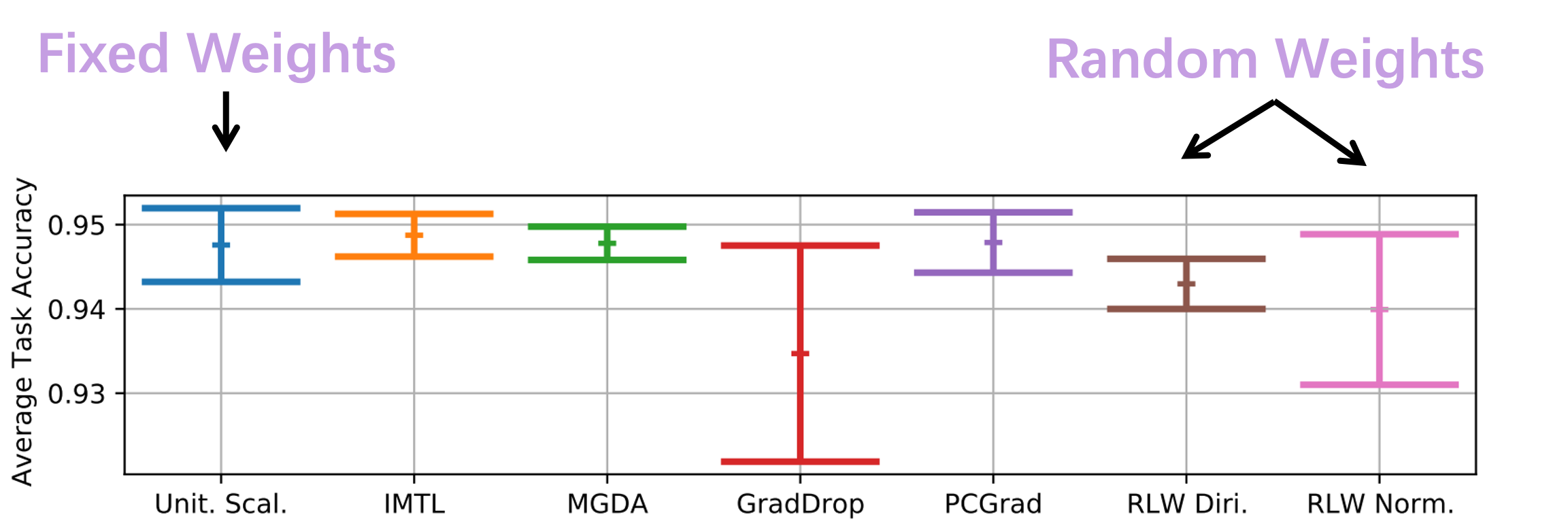
- The Gap: Training Loss -> Training Performance -> Testing Performance
- A sufficiently large enough model can learn all tasks simultaneously
- $^1$In Defense of the Unitary Scalarization for Deep MTL, NeurIPS 2022.
- $^2$Do Current Multi-Task Optimization Methods in Deep Learning Even Help? NeurIPS 2022.
- $^3$Reasonable Effectiveness of Random Weighting: A Litmus Test for MTL, TMLR 2022.
Future Directions
- Task Relations:
- Efficiently Identifying Task Groupings for Multi-Task Learning, NeurIPS 2022.
- Auto-Lambda: Disentangling Dynamic Task Relationships, TMLR 2022.
- Knowledge Transfer:
- Pareto Self-Supervised Training for Few-Shot Learning, CVPR 2021.
- Pareto Domain Adaptation, NeurIPS 2021.
- Truely Conflicted Objectives:
- Neural Architecture Search
- Fairness v.s. Performance
- Limited Capacity (e.g., on Edge Device)